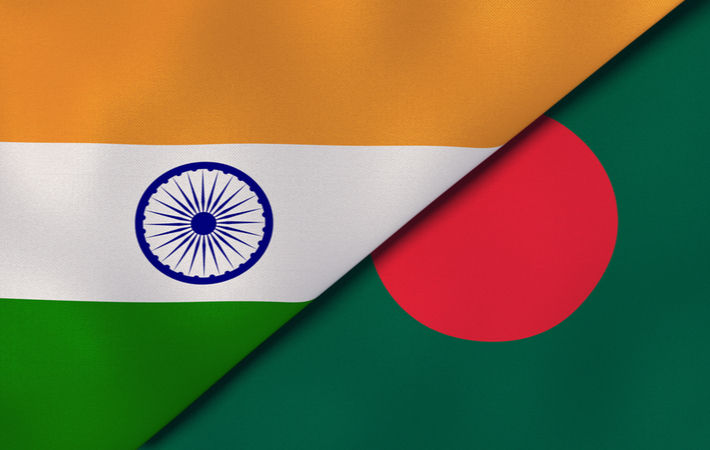Interviews
FTA can raise Bangladesh's exports to India by 182%: World Bank
15 Mar '21
4 min read

Pic: Shutterstock
A free trade agreement (FTA) could increase Bangladesh's exports to India by 182 per cent and by 126 per cent the other way round, according to a new World Bank report, which said improving transport connectivity could take it even further by 297 per cent and 172 per cent respectively. The border could be made irrelevant from a trade perspective by removing barriers.
The World Bank’s Dhaka and India offices recently jointly released the report titled ‘Connecting to Thrive: Challenges and Opportunities of Transport Integration in eastern South Asia’.
The report pointed out that high tariffs, para-tariffs and nontariff barriers were the major hurdles between the neighbours. The duo's average tariff was more than twice the world average, it said.
Complicated and non-transparent nontariff measures, which are policy measures other than tariffs that affect the free flow of goods and services across borders, add to the high trade costs.
As a result, bilateral trade currently accounts for only about 10 per cent of Bangladesh's trade and a mere 1 per cent of India's trade.
Meanwhile in East Asian and Sub-Saharan African economies, intraregional trade accounts for 50 per cent and 22 per cent of total trade respectively, the report said.
It is about 15-20 per cent less expensive for an Indian company to trade with a company in Brazil or Germany than with a company in Bangladesh, the report pointed out.
Economic activity in Bangladesh is concentrated in Dhaka and Chattogram while bordering and poorly connected districts lag behind.
Night time light intensity per capita across the country highlights the concentration of economic activity around the capital.
Traditionally, the districts between the western border with India and Jamuna river have lagged behind the eastern part of the country, largely because of their limited connectivity and hence, limited market access.
Poverty in southwest Bangladesh is higher than in most eastern districts, the World Bank report said.
Western districts are far away from the capital and the main seaport in Chattogram because of the Jamuna river, which is crossable via only a single bridge.
These western districts' access to Indian markets is very limited because of the thick border with India, even though they are only a short distance from Kolkata.
All districts in Bangladesh would benefit from integration, with the eastern districts enjoying larger gains in real income.
Bangladeshi districts would see reductions in prices of goods and inputs from India and receive higher prices for their exports, becoming more competitive, the report said.
The eastern districts would benefit the most because of their comparative advantage, which would lead the southeastern workers to migrate to the north and east, raising real wages by as much as 37 per cent.
On connecting local markets, the report said that regional trade and transport initiatives typically linked major centres and trade gateways.
The initiatives are often designed around corridors that offer superior infrastructure, harmonised policies and procedures to facilitate trade and transport and supportive institutional mechanisms to coordinate among the many stakeholders.
Corridors are high-capacity systems that are most efficient when they facilitate the unimpeded movement of large volumes of traffic.
In order to benefit the communities and centres in regions through which the corridors pass, it is important to create on and off ramps for rural communities and intermediate centres to access each corridor.
As doing so could compromise the efficiency of a corridor, there is a need for careful design of local access solutions.
The report also stressed on the need for taking several measures to improve women's participation in export-oriented agricultural value chains.
These measures need to be grounded in the realities of women's lives and the fact that gender norms change slowly.
The most effective strategies are ones that are applied to value chain products and processes in nodes in which women are already participating.
Removing blockages to adding value at these nodes and increasing women's control of income over benefits can have direct impacts on returns to female value chain participants and be used to incrementally facilitate behaviour and norm changes.
In designing these strategies, care should be exercised to ensure that there are no unintended consequences for women in terms of increased violence against them, the World Bank said in its report.
The World Bank’s Dhaka and India offices recently jointly released the report titled ‘Connecting to Thrive: Challenges and Opportunities of Transport Integration in eastern South Asia’.
The report pointed out that high tariffs, para-tariffs and nontariff barriers were the major hurdles between the neighbours. The duo's average tariff was more than twice the world average, it said.
Complicated and non-transparent nontariff measures, which are policy measures other than tariffs that affect the free flow of goods and services across borders, add to the high trade costs.
As a result, bilateral trade currently accounts for only about 10 per cent of Bangladesh's trade and a mere 1 per cent of India's trade.
Meanwhile in East Asian and Sub-Saharan African economies, intraregional trade accounts for 50 per cent and 22 per cent of total trade respectively, the report said.
It is about 15-20 per cent less expensive for an Indian company to trade with a company in Brazil or Germany than with a company in Bangladesh, the report pointed out.
Economic activity in Bangladesh is concentrated in Dhaka and Chattogram while bordering and poorly connected districts lag behind.
Night time light intensity per capita across the country highlights the concentration of economic activity around the capital.
Traditionally, the districts between the western border with India and Jamuna river have lagged behind the eastern part of the country, largely because of their limited connectivity and hence, limited market access.
Poverty in southwest Bangladesh is higher than in most eastern districts, the World Bank report said.
Western districts are far away from the capital and the main seaport in Chattogram because of the Jamuna river, which is crossable via only a single bridge.
These western districts' access to Indian markets is very limited because of the thick border with India, even though they are only a short distance from Kolkata.
All districts in Bangladesh would benefit from integration, with the eastern districts enjoying larger gains in real income.
Bangladeshi districts would see reductions in prices of goods and inputs from India and receive higher prices for their exports, becoming more competitive, the report said.
The eastern districts would benefit the most because of their comparative advantage, which would lead the southeastern workers to migrate to the north and east, raising real wages by as much as 37 per cent.
On connecting local markets, the report said that regional trade and transport initiatives typically linked major centres and trade gateways.
The initiatives are often designed around corridors that offer superior infrastructure, harmonised policies and procedures to facilitate trade and transport and supportive institutional mechanisms to coordinate among the many stakeholders.
Corridors are high-capacity systems that are most efficient when they facilitate the unimpeded movement of large volumes of traffic.
In order to benefit the communities and centres in regions through which the corridors pass, it is important to create on and off ramps for rural communities and intermediate centres to access each corridor.
As doing so could compromise the efficiency of a corridor, there is a need for careful design of local access solutions.
The report also stressed on the need for taking several measures to improve women's participation in export-oriented agricultural value chains.
These measures need to be grounded in the realities of women's lives and the fact that gender norms change slowly.
The most effective strategies are ones that are applied to value chain products and processes in nodes in which women are already participating.
Removing blockages to adding value at these nodes and increasing women's control of income over benefits can have direct impacts on returns to female value chain participants and be used to incrementally facilitate behaviour and norm changes.
In designing these strategies, care should be exercised to ensure that there are no unintended consequences for women in terms of increased violence against them, the World Bank said in its report.
Fibre2Fashion News Desk (DS)
Popular News
Leave your Comments
Editor’s Pick
































-Ltd..jpg?tr=w-120,h-60,c-at_max,cm-pad_resize,bg-ffffff)





.jpg?tr=w-120,h-60,c-at_max,cm-pad_resize,bg-ffffff)
.jpg?tr=w-120,h-60,c-at_max,cm-pad_resize,bg-ffffff)






